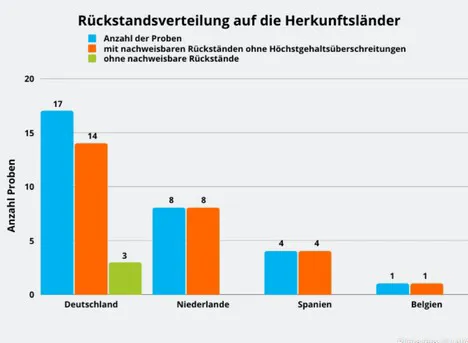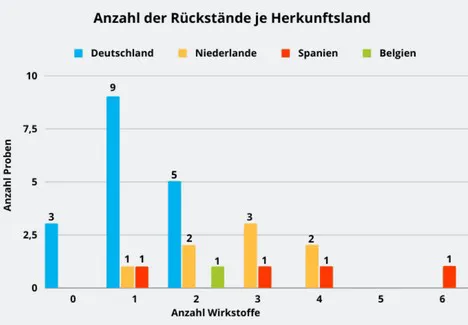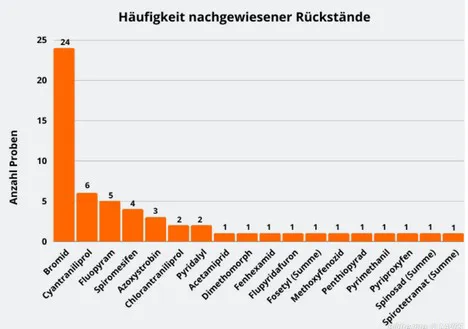In 2022, a total of 30 samples of tomatoes were analyzed for pesticide residues. Residues were detectable in 27 samples. Three samples were free of residues. Maximum content exceedances and unauthorized pesticide applications were not detected.
At the Oldenburg Food and Veterinary Institute of LAVES, a total of 30 tomato samples were analyzed for pesticide residues in 2022. Most of the sampling took place in the 3rd quarter of 2022, as a result of which a disproportionately large number of tomato samples from German production came for examination. All in all, 17 samples came from Germany, 8 samples from the Netherlands, 4 samples from Spain, and 1 sample came from Belgium.
 © LAVES
© LAVES
Of the total 30 samples, 2 organic samples came from Germany, and 1 organic sample came from Spanish production. As Figure One summarizes, no pesticide residues were detected in 3 tomato samples (= ten percent) from German cultivation. In all other 27 samples (= 90 percent), residues were detectable.
No maximum levels were exceeded, and no unauthorized pesticide applications were detected in tomato samples from Germany.

Figure two shows the number of residues detected per sample. Multiple residues, i.e., more than one active ingredient per sample, were determined in 16 samples (= 53 percent) of the tomatoes tested. In eleven samples, and thus most frequently, only one active ingredient was detected in the samples, of which nine samples originated from German production. With six different residues, one sample of tomatoes from Spanish cultivation formed the maximum of multiple residues. The samples of German tomatoes with a maximum of two active substances tended to perform better than the Spanish and Dutch samples. The Dutch tomato samples contained up to a maximum of four and the Spanish up to a maximum of six different pesticide residues.
Figure three shows the spectrum of active ingredients detected in the samples. In 27 tomato samples, 18 different active ingredients were detectable. Bromide was determined in 24 samples, by far the most common, including in the three biosamples. Bromide was the only residue present in nine samples. Bromide can occur as a pesticide residue of bromine-containing fumigants used for the disinfestation of greenhouses but can also occur naturally in the soil of certain growing regions. Unfortunately, the origin of the bromide residues in the samples cannot be determined purely analytically.

No maximum level exceedances found in German tomatoes
Pesticide applications In contrast to 2021 and 2019, the 2022 samples were also analyzed for bromide. The bromide detections resulted in a higher number of samples with residues than in the two previous years, where this parameter was not in the testing spectrum. Excluding bromide, 60 percent of the 2022 samples would have contained pesticide residues. Maximum level exceedances and unauthorized pesticide applications in samples from German cultivation were not recorded in 2022.
Source and images: LAVES
